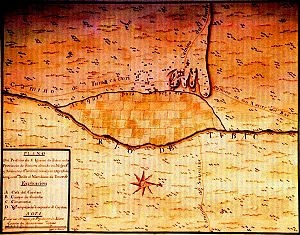- Pima Revolt
-
Mexican Indian Wars - Conquest of the Yucatan - Conquest of the Aztec Empire - Conquest of Guatemala - Yaqui Wars - Mixtón War - Chichimeca War - Acaxee Rebellion - Acoma War - Comanche-Mexico Wars - Apache-Mexico Wars - Navajo Wars - Tepehuán Revolt - Pueblo Revolt - Pima Revolt - 1st Magdalena MassacreIndian wars and conflicts of ArizonaYaqui Wars - Pima Revolt - Yuma War - Sitgreaves Expedition - Battle of Pima Butte - Ute Wars - Apache Wars - Chiricahua Wars - Mohave War - Navajo Wars - Yavapai Wars - Hualapai War - Black Hawk's War - Yavapai War - Victorio's War - Geronimo's War - Renegade Period - Yaqui Uprising
The Pima Revolt, or the O'odh am Uprising and the Pima Outbreak, was a revolt of Pima native Americans in 1751 against colonial forces in Spanish Arizona and one of the major northern frontier conflicts in early New Spain.
Contents
Background
The revolt was a culmination of a period of low-level violence against the local Spanish settlers since 1684. The period was characterized by a gradual loss of autonomy and territory by the Native Americans, as treaties allowing mining and herding by the Spanish on native lands were eroded by an influx of new settlers; by 1760 Spaniards and Mexicans outnumbered Native Americans in the present-day American Southwest. However, the colonial province of Sonora was characterized by a larger native population, and more frequent conflict between them and the Spaniards.[1] The Pima Indian Revolt was directly preceded by the Seri Revolt of Seri Indians in Sonora.[2]
Uprising
While the Pima people had no central authority, the charismatic Luis Oacpicagigua (Luis of Sáric) began the task of uniting—with varying degrees of success—the disparate groups, numbering at least 15,000 people, under a single war plan. The initial act of rebellion was the massacre of 18 settlers lured to Oacpicagigua's home in Sáric.[2] In the ensuing three months, Oacpicagigua and more than a hundred other men attacked the mission at Tubutama, and other Spanish settlements, and more than a hundred settlers were killed. Oacpicagigua surrendered to Captain José Díaz del Carpio on March 18, 1752 after a negotiated peace. When the Pima leaders laid the blame for the revolt on Jesuit missionaries (who would be expelled from Spain and its colonies in 1767) they were pardoned by the colonial governor Ortiz Parrilla.[2]
After the conflict
Small scale conflict soon began again, however, and Oacpicagigua eventually died in a Spanish prison in 1755. The colonial government founded three new presidios in Sonora to control the Pima and Seri populace in the years after the revolt: San Ignacio de Tubac, Santa Gertrudis de Altar, and San Carlos de Buenavista, present-day Tubac, Arizona, Altar, Sonora, and Buenavista, Sonora, respectively.[3] While intermittent rebellions continued, by the end of the eighteenth century, Sonoran natives had been largely missionized or Hispanicized, and the assimilated tribes of frontier New Spain were absorbed into the Spanish Empire.
References
- ^ Ewing, Russell C. (October 1938). "The Pima Outbreak in November, 1751". New Mexico Historical Review XIII (4): pp. 337–46.
- ^ a b c Roberto Mario Salmón (July 1988). "A Marginal Man: Luis of Saric and the Pima Revolt of 1751" (JSTOR). The Americas (The Americas, Vol. 45, No. 1) 45 (1): pp. 61–77. doi:10.2307/1007327. JSTOR 1007327.
- ^ John Francis Bannon (July 1979). "The Mission as a Frontier Institution: Sixty Years of Interest and Research" (JSTOR). The Western Historical Quarterly (The Western Historical Quarterly, Vol. 10, No. 3) 10 (3): pp. 303–322. doi:10.2307/967373. JSTOR 967373.
External links
- Henry F. Dobyns (1999) (full text). Tubac Through Four Centuries: An Historical Resume and Analysis. Arizona State Parks Board. pp. "CHAPTER V: THE PIMA REVOLT OF 1751". http://parentseyes.arizona.edu/tubac/cpt5-int.htm.
Categories:- Wars fought in Arizona
- Conflicts in 1751
- Conflicts in 1752
- Pre-state history of Arizona
- Colonial Mexico
- Rebellions against the Spanish Empire
Wikimedia Foundation. 2010.

